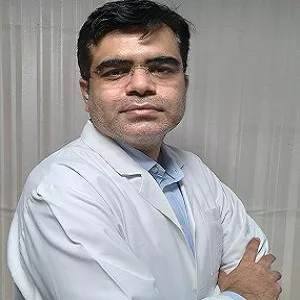Venous Insufficiency Treatment in Chunni-ganj, Kanpur
Veins and arteries are two very important parts of the circulatory system in our blood. Like arteries carry fresh, oxygen-rich blood from the heart to other body parts, veins transport that blood back to the heart. When the wall of the veins in our body are damaged, obstructions are caused in the circulation of blood as it collects and begins to flow backwards. Such malfunctioning can further build high pressure inside the veins and lead to other problems like:
- Swollen veins
- Stretched and twisted veins
- Valve dysfunction
- Blood clotting

Symptoms of venous diseases
Most venous diseases have symptoms that occur in the veins present inside the legs. Common symptoms include:
Deep-vein thrombophlebitis
- Bluish skin colour in the limb or toes or cyanosis
- Distention of superficial veins
- Swelling, warmth, and redness in the affected limb
Superficial Thrombophlebitis
- Tenderness around the swollen area
- Pain
- Red, swollen veins
Varicose Veins
- Ulcers on the inner side of the ankles
- Skin discolouration
- Itching skin above the affected veins
- Feeling pain or heaviness in the legs
- Swelling in the legs or oedema
- Enlarged and swollen clusters of purple veins twisted into knots
Causes of venous diseases
The causes that can lead to venous diseases vary from person to person. There may also be more than one of the following causes that can be associated with one of the venous diseases:
- A variety of cancers can also have deep-vein thrombophlebitis as an associated medical condition
- Pregnant women and people with varicose veins are at a higher risk of superficial thrombophlebitis
- Conditions that increase the risk of blood clottings
- Injury of the blood vessel caused by trauma or infection
- Stagnation of blood due to immobility. This happens mostly in bedridden patients and healthy persons who sit or lie still for long periods
When these issues occur persistently, they can further develop into various other medical conditions known as Venous Diseases. Some of these conditions are:
- Deep-vein Thrombophlebitis
This condition involves similar symptoms to what happens in superficial thrombophlebitis but it is more serious since it affects larger veins present deep below in the skin. Half of the cases of deep-vein thrombophlebitis are asymptomatic, however, if not treated in time, it can develop into a pulmonary embolism or chronic venous insufficiency.
- Superficial Thrombophlebitis
This condition occurs when inflammation is due to blood clotting in the blood vessels of the legs. When such inflammation is found in a vein close to the surface of the skin, it is called superficial thrombophlebitis.
- Varicose Veins
A commonly occurring problem, varicose veins refer to swelling of the veins that are near the surface of the skin due to weak or damaged valves that allow blood to flow backwards or collect within the vein. Varicose veins can also be caused due to persistent obstruction of the veins. This condition usually occurs in the legs and can be easily treated if needed.
Venous diseases occur quite commonly among the population of India. According to studies, between the ages of 40 and 80, 22 million women and 11 million men were found to be affected by varicose veins. While a total of two million men and women were expected to develop symptoms of venous ulcers and other chronic venous insufficiencies.
While conditions like varicose veins and venous ulcers can be treated and do not exhibit any life-threatening symptoms, other venous diseases like thrombophlebitis have much more serious and even life-threatening symptoms.
When to see a doctor at Apollo Spectra, Kanpur?
In case you experience any of the mentioned symptoms for a prolonged period, immediately contact your doctor for a timely diagnosis and required treatment.
Request an appointment at Apollo Spectra Hospitals, Kanpur
Call 1860-500-2244 to book an appointment
How are venous diseases treated at Apollo Spectra, Kanpur?
There are various surgical and non-surgical methods to treat different venous diseases. These include:
- Sclerotherapy
- Laser therapy
- Surgical ligation (tying off) or removal of the varicose vein
- Bed rest and elevation of the affected limb
- Anti-clotting medication
- Filter implantation to prevent clotting
- Clot-dissolving agents
- Special elastic support stockings to support circulation
While varicose veins can be self-diagnosed by observing your veins and noting if there are any symptoms present. Diagnosis of superficial thrombophlebitis is done through evaluating your medical history and a physical examination.
Recovery usually takes 1 to 4 weeks after varicose vein surgery. Your doctor may ask you to avoid or limit any strenuous activities.
Exercising regularly can help reduce the pain and the possibility of deep vein thrombosis.
Symptoms
Our Doctors
DR. ACHINTYA SHARMA
MBBS, MS,MCh...
| Experience | : | 7 Yeras Experience |
|---|---|---|
| Speciality | : | Vascular Surgery... | Location | : | Chunni Ganj |
| Timings | : | Available by prior a... |
Our Top Specialities
NOTICE BOARD
CONTACT US
CONTACT US
 Book Appointment
Book Appointment



.svg)
.svg)
.svg)
.svg)








